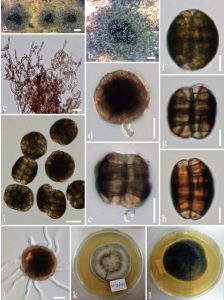Hermatomyces saikhuensis Tibpromma, D.J. Bhat & K.D. Hyde, sp. nov., Index Fungorum number: IF 552309
Etymology: refers to the Sai Khu waterfall where the fungus was collected.
Holotype:—MFLU16-1930
Saprobic on dead leaves of Pandanus odorifer. Sexual morph: Undetermined. Asexual morph: Colonies on natural substrate dry, blackish brown, velvety, circular, doughnut-shaped, dull, consisting of a sterile mycelial outer zone and a round, glistening, abundantly sporulating centre, conidia readily liberated when agitated. Mycelium 1.1–2.5 μm wide, superficial, composed of a network of branched, septate, brown, thick-walled, smooth hyphae. Conidiophores 3–5.2 μm long, 1.7–2.8 μm wide, micronematous, straight or flexuous, pale brown, smooth, unbranched, arising from prostrate hyphae at the centre of circular colony. Conidiogenous cells holoblastic, monoblastic, integrated, terminal, cylindrical, hyaline to subhyaline. Conidia monomorphic, thick-walled, smooth, lenticular on top view, fattened and disk-shaped in lateral view, 14.2–21.4 µm high, 11.2–19.3 µm wide ( x = 17.5 × 17 µm, n = 30), with central cells dark brown to black, with peripheral cells subhyaline to pale brown. Two halves of the disk-shaped conidia symmetrically adpressed, forming a deep constriction at lower and upper end in lateral view, each half with 6–7 cells, hyaline to light brown at lower and upper cells, dark brown in middle cells.
Culture characteristics: Colonies on MEA at room temperature (22–25 ºC) reaching 2.5 cm in 1 week, circular with wavy margin, white-grey, smooth surface and raised, not sporulating in culture after 4 months.
Material examined: THAILAND, Prachuap Khiri Khan Province, Sai Khu waterfall, on dead leaves of Pandanus odorifer (Pandanaceae), 30 July 2015, S. Tibpromma & K.D. Hyde, SF15-015 (MFLU16-1930, holotype, HKAS94531, isotype); ex-type living culture, MFLUCC16-0266.
Notes: Similar to Hermatomyces saikhuensis, both H. sphaericum and H. tucumanensis produce only one type of conidia (Castañeda & Heredia 2000). However, Hermatomyces saikhuensis can be differentiated by its shape, colour and size of conidia. In H. sphaericum the conidia are lenticular to elliptical, with pale peripheral cells (Castañeda & Heredia 2000). Hermatomyces tucumanensis has subglobose to broadly oval conidia with pale peripheral cells (Castañeda & Heredia 2000). In H. saikhuensis the lenticular conidia with subhyaline to pale brown peripheral cells are paler than the previously described species. In size, the conidia of H. saikhuensis (14.2–21.4 μm) are smaller than both H. sphaericum (26–31 × 25–50 μm) and H. tucumanensis (29–42 × 19–25 μm).

